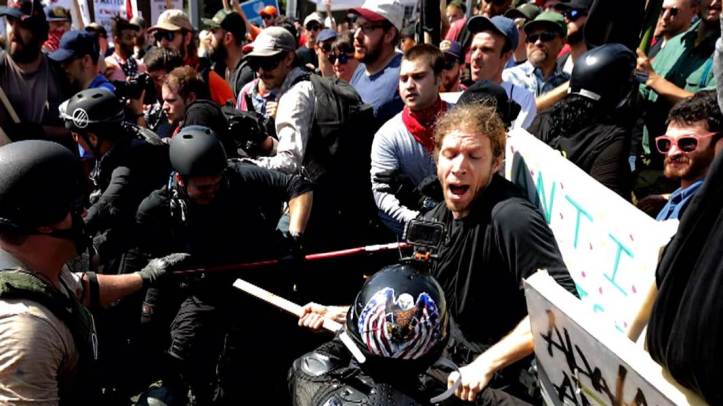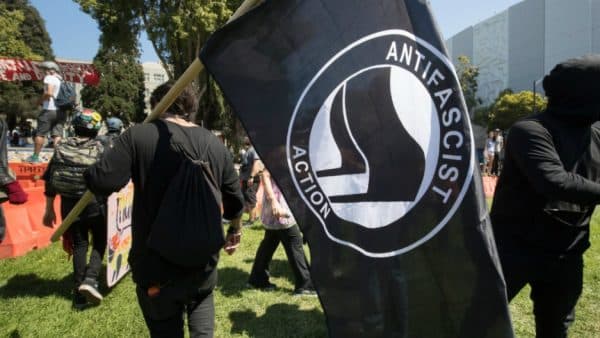Gabriel Rockhill is a Franco-American philosopher, cultural critic and activist. He is Associate Professor of Philosophy at Villanova University and founding Director of the Atelier de Théorie Critique at the Sorbonne. His books include Counter-History of the Present: Untimely Interrogations into Globalization, Technology, Democracy (2017), Interventions in Contemporary Thought: History, Politics, Aesthetics (2016), Radical History & the Politics of Art (2014) and Logique de l’histoire (2010). In addition to his scholarly work, he has been actively engaged in extra-academic activities in the art and activist worlds, and he is one of the co-founders of the Radical Education Department (RED). Follow on twitter: @GabrielRockhill
To take but one glaring example, the dominant mass media image of antifa has recently been consolidated by Chris Hedges, who has indisputably demonstrated that public figures associated with the Left can sometimes serve the agenda of the Right better than their own foot soldiers. From a privileged vantage point far removed from the violence enacted by white supremacists, Hedges peremptorily proclaimed that antifascist direct action that openly confronts fascist violence is nothing but the mirror of the latter.

This work is licensed under a Creative Commons Attribution-NonCommercial 4.0 International License.
BONUS FEATURE
“Breaching the Liberal Illusion: Against Hedges” – JPS
Untroubled by their strange bedfellow, liberals echo Trump’s condemnation of “both sides.” Chris Hedges’ recent article in Truthdig is only one among a number of these echoes. Hedges calls for the left to reject both white supremacists and antifa as fringe, extremist groups that are identical in their fetishization of violence. This is a narrative that refuses to see the real conditions that antifa faces. In doing so, it bolsters the reactionary agenda.
Hedges’ essay must first be rejected for its method. Its analysis boldly refusal to consider anything so mundane as historical detail. This approach leads to a series of sloppy comparisons drawn from a bewildering array of eras and contexts. One wonders: were the activists who recently protected unarmed clergywomen and -men from racists holding torches in Charlottesville quite the same as paramilitary communists in Weimar Germany during the 1920s? In fact, should we really dismiss all militant resistance to the rise of National Socialism and its genocidal project in interwar Germany, as Hedges seems to do? The assertions he makes about Latin American revolutionary and counterrevolutionary violence should alarm anyone familiar with this history and reveal the functionality of his argument for justifying right-wing violence. For example, the comparisons he draws between left-wing revolutionary organizations and right-wing death squads backed by an authoritarian state, as well as the power of the global imperial hegemon, have not only been widely refuted in Latin American contexts, but recognized for their function as apologias for state terrorism and political genocide.
Hedges’ method also leads him to dramatic, sweeping claims that show a similar disrespect for history and detail. Antifa is, at bottom, a pure lust for violence. Pay no attention to the actual, highly nuanced arguments made by participants, or to the fact that antifa is a broad coalition that harbors a wide range of views and practices. When the movement wears black, it embodies “the color of death.” No need to consider the history of the anarchist use of the color black (in its flag, for example), or the tactical value of dressing in identical, nondescript clothes as a tool for coordinating and remaining anonymous.
This superficial method grounds the article’s glaring failures. Hedges’ argument rests in large part on this claim:
“The conflict will not end until the followers of the alt-right and the anti-capitalist left are given a living wage and a voice in how we are governed.”
We are told the primary social issues at play are political and economic; the racial hatred clear in Charlottesville and the Trump administration is secondary. This approach is tactically disastrous. Are we to think that treating white supremacy as secondary will help build lasting, vibrant, mass coalitions with which to oppose Trump? Doesn’t this in fact stand opposed to some of the most important, powerful, and broad-based struggles today that see race as a central issue?
But Hedges is not making a merely tactical mistake. White supremacy is not simply an extremist stance taken by those lacking a political voice and experiencing economic hardship. A recent preliminary study suggests that Trump voters were concerned more with racial concerns than economic ones. Moreover, we live in a country founded by wealthy men who were eminently politically enfranchised (they built the very structures of American government) and who thought little of slavery or the mass eradication of indigenous peoples and cultures. Christopher Patrella notes that the Ku Klux Klan “were the well-educated elites of their day.” The spokespeople of white supremacy–the German philosopher Immanuel Kant, for example–were cultural and economic elites. They framed racist ideology as a “science,” aiming to prove the natural inferiority of nonwhites. This tradition is unbroken. It is carried on today by “scientific” frauds like the eugenicist academic Charles Murray.
Frantz Fanon’s work shows, again and again, that white supremacy isn’t simply a fringe belief held by the desperate. It stands at the core of the western world’s dominant conception of order, beauty, and harmony. White supremacy is essential to how this country–though certainly not only this country–operates. It shapes how wealth, prestige, and rights are distributed; who occupies the positions of highest authority; and who may be murdered without legal consequence.
The article’s ultimate failure lies in its inability to see the centrality and enormity of the problem of white supremacy. Hedges argues that force must not be used to disrupt and defend against ever bolder fascists and white supremacists. According to this account, if we don’t challenge them, we’re safe. It is astonishing that Hedges, who sees in white supremacists a “lust for violence,” never considers the possibility that vulnerable communities will be increasingly targeted by a radical right made bolder by a society that respects their toxic ideology as a legitimate point of view. More importantly, despite his avowed suspicion of American government, Hedges refuses to acknowledge that white supremacy structures and is actively and passively cultivated by the state, which thereby encourages the violent domination of minorities. Indeed, Hedges seems to harbor an unspoken faith that the state will serve as a neutral bulwark against the expansion of racist violence; things will not be allowed to get out of hand, if we just let the racists have their say. The police–no neutral force–are giving free reign to the radical right while cracking down on antifa, as seen in Boston and Charlottesville. Trump’s pardoning of Joe Arpaio signals his support for white supremacy, as did his delay in condemning both the Ku Klux Klan during his presidential campaign and white supremacists after Charlottesville. The president is vowing to restart the flood of military weapons into local police, equipment that fueled the obscene state response to uprisings in Ferguson. Attorney General Jeff Sessions has thrown his support behind mass incarceration. Again and again, the president has encouraged the extra-legal use of violence against activists.

Unsurprisingly, this context has given rise to an increase of racially motivated violence. Indeed, when the government supports and protects white supremacist violence by the rank-and-file, one finds not only increasing attacks on vulnerable communities, but also a transformation of the legal structure. In Germany in the 1980s and 1990s, for example, the repeated outbreak of neo-Nazi violence, to which the state turned a blind eye, drove the passage of anti-immigration laws.[1]
Hedges’ condemnation of antifa amounts to a refusal to grapple with these conditions in the naive faith that, if we simply leave the radical right alone, they will go away. It is in this context that we must understand antifa. It is not the “mirror” of an extremist fringe of the right. It is the clear recognition of, and an attempt to challenge and transform, a terrifying situation that Hedges refuses to see.
[1] Georgy Katsiaficas, The Subversion of Politics: European Autonomous Social Movements and the Decolonization of Everyday Life (Oakland; Edinburgh: AK Press, 161.
Appendix
[premium_newsticker id=”154171″]
Parting shot—a word from the editors
The Best Definition of Donald Trump We Have Found
 In his zeal to prove to his antagonists in the War Party that he is as bloodthirsty as their champion, Hillary Clinton, and more manly than Barack Obama, Trump seems to have gone “play-crazy” -- acting like an unpredictable maniac in order to terrorize the Russians into forcing some kind of dramatic concessions from their Syrian allies, or risk Armageddon.However, the “play-crazy” gambit can only work when the leader is, in real life, a disciplined and intelligent actor, who knows precisely what actual boundaries must not be crossed. That ain’t Donald Trump -- a pitifully shallow and ill-disciplined man, emotionally handicapped by obscene privilege and cognitively crippled by white American chauvinism. By pushing Trump into a corner and demanding that he display his most bellicose self, or be ceaselessly mocked as a “puppet” and minion of Russia, a lesser power, the War Party and its media and clandestine services have created a perfect storm of mayhem that may consume us all.— Glen Ford, Editor in Chief, Black Agenda Report
In his zeal to prove to his antagonists in the War Party that he is as bloodthirsty as their champion, Hillary Clinton, and more manly than Barack Obama, Trump seems to have gone “play-crazy” -- acting like an unpredictable maniac in order to terrorize the Russians into forcing some kind of dramatic concessions from their Syrian allies, or risk Armageddon.However, the “play-crazy” gambit can only work when the leader is, in real life, a disciplined and intelligent actor, who knows precisely what actual boundaries must not be crossed. That ain’t Donald Trump -- a pitifully shallow and ill-disciplined man, emotionally handicapped by obscene privilege and cognitively crippled by white American chauvinism. By pushing Trump into a corner and demanding that he display his most bellicose self, or be ceaselessly mocked as a “puppet” and minion of Russia, a lesser power, the War Party and its media and clandestine services have created a perfect storm of mayhem that may consume us all.— Glen Ford, Editor in Chief, Black Agenda Report










IDEAS defended with violence are all same